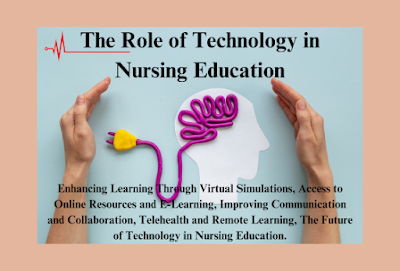Role of Technology in Nursing Education
Technology in Nursing Education Technology has significantly transformed various aspects of our lives, including education. In the field of nursing, where precision, knowledge, and hands-on experience are crucial, technology plays an indispensable role in modernizing learning. From virtual simulations to telehealth, technology is revolutionizing how nursing students acquire and apply their knowledge. This comprehensive article explores how technology is reshaping nursing education and what the future holds.
Enhancing Learning Through Virtual Simulations
The Role of Technology in Nursing Education. One of the most significant advancements in nursing education brought about by technology is the introduction of virtual simulations. Traditionally, nursing students relied on real-life clinical situations to hone their skills. However, these opportunities were often limited, and mistakes in real-life settings could lead to serious consequences.
With virtual simulations, students can now practice essential clinical skills in a safe, controlled environment. These simulations replicate a variety of scenarios, from routine procedures to emergency interventions, allowing students to practice until they achieve mastery. By providing a risk-free environment, virtual simulations help build confidence and ensure that students are well-prepared for real-world clinical situations.
Access to Online Resources and E-Learning
The advent of online resources and e-learning platforms has also dramatically impacted nursing education. In the past, nursing students were restricted to textbooks and in-person lectures. Today, the internet provides an abundance of readily available information that students can access anytime, anywhere.
The Role of Technology in Nursing Education. E-learning platforms offer interactive courses, videos, quizzes, and discussion forums where students can engage with peers and instructors. This flexibility allows students to learn at their own pace, revisit difficult concepts, and balance their education with other responsibilities. Additionally, online materials are frequently updated, ensuring that students stay up-to-date with the latest developments in the healthcare field.
Improving Communication and Collaboration
Technology has also transformed how nursing students and educators communicate and collaborate. Previously, face-to-face meetings or written assignments were the primary means of interaction. However, digital tools like email, instant messaging, and video conferencing now enable students to connect with instructors and peers effortlessly and in real-time.
These communication tools allow for instant feedback, helping students resolve any misunderstandings quickly. Furthermore, online collaboration platforms allow students to work together on group projects, share resources, and discuss ideas, fostering a collaborative learning environment even when students are not physically present together.
The Role of Mobile Technology in Nursing Education
Mobile technology has significantly impacted nursing education by making learning accessible on the go. Smartphones and tablets have become essential tools for nursing students, providing instant access to educational apps, training materials, and communication channels. These devices enable students to study and review materials whenever they have free time, making learning more flexible and efficient.
The Role of Technology in Nursing Education. Numerous apps are available for nursing students, offering resources like flashcards, drug reference guides, and clinical decision-making tools. These apps help students prepare for exams and develop the skills they will need in their future roles. Additionally, electronic health records (EHRs) are integrated into mobile platforms, allowing students to gain hands-on experience with the digital tools they will use in their professional practice.
Telehealth and Remote Learning
The COVID-19 pandemic underscored the importance of technology in healthcare and nursing education by accelerating the adoption of telehealth and remote learning. The ability to provide care remotely is becoming an essential skill, and telehealth technology allows nursing students to practice these skills in virtual settings.
Through telehealth simulators, students can conduct virtual consultations, perform remote patient assessments, and make informed decisions using digital data. As telehealth continues to expand, especially in rural and underserved areas, gaining experience in remote healthcare delivery will become increasingly valuable.
During the pandemic, nursing programs swiftly transitioned to online learning, incorporating virtual labs, digital courses, and online assessments. These changes allowed nursing education to continue uninterrupted and highlighted the resilience of technology-enhanced learning.
The Future of Technology in Nursing Education
Looking ahead, the future of nursing education will be shaped by emerging technologies such as artificial intelligence (AI), virtual reality (VR), and augmented reality (AR). AI has the potential to personalize learning experiences, offering customized support based on each student’s strengths and weaknesses. This individualized approach could help students overcome challenges and optimize their learning outcomes.
Meanwhile, VR and AR are poised to revolutionize nursing education by creating immersive, realistic training environments. These technologies will allow students to practice complex procedures in a simulated setting, offering hands-on experience without the risks associated with real-life patient care. As VR and AR become more affordable and widely accessible, they will likely become a staple in nursing education.
Conclusion
Technology is undeniably reshaping nursing education, offering innovative tools and resources that enhance learning, improve collaboration, and prepare students for the future of healthcare. From virtual simulations to telehealth and the integration of AI and VR, the future of nursing education is bright, promising a more dynamic and accessible learning environment for students around the world. As technology continues to evolve, so too will the ways in which nursing students learn, adapt, and thrive in the healthcare profession.
Read More: https://nurseseducator.com/the-role-of-technology-in-nursing-education/

1 thought on “The Role of Technology in Nursing Education”